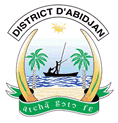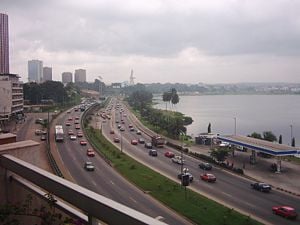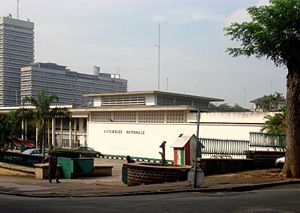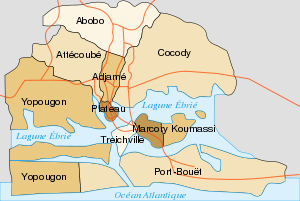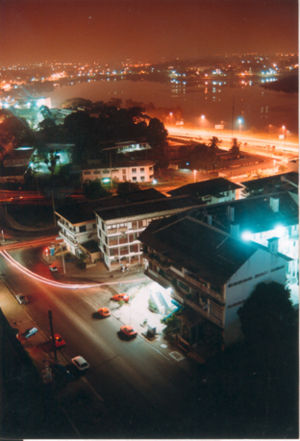Abidjan
| |||
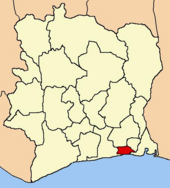
| |||
| Region | Lagunes | ||
| District Governor | Pierre Djédji Amondji (FPI) (since 2002) | ||
| Area | 2,119 km² | ||
| Subdivisions | 10 communes of Abidjan City 3 subprefectures outside of Abidjan City | ||
| Population 2003 official estimate 1998 census |
3,660,682 3,125,890 | ||
| Density | 1,728/km² (2003) | ||
| Web site | www.abidjan-da.ci | ||
Abidjan is the largest city and former capital of Côte d'Ivoire (Ivory Coast). It is the commercial and banking center of Côte d'Ivoire as well as the de facto capital. (Yamoussoukro is the official capital.) It is also the most populated city in French-speaking Western Africa. It stands in Ébrié Lagoon on several converging peninsulas and islands, connected by bridges. There are an estimated 4 to 5 million inhabitants in the metropolitan area.[citation needed] In the region, this is second only to Lagos, the previous English capital of Nigeria. Abidjan is actually considered the cultural crossroads of West Africa.
Geography
The name name "Abidjan" (formerly Abijean) came from a misunderstanding, according to an Ebrié legend. An old man, returning from his field with an armful of branches, happened to encounter a lost European explorer who asked him the name of the nearest village. Unable to speak the white man's language, the old man believed he had been asked what he was doing there. Fleeing in terror, the old man shouted: "tchan me bidjan" which in the Ebrié language means "I've just been cutting branches!" The white man took this to be the name "Abidjan."
The Metropolitan area of Abidjan is located in Southern Ivory Coast on the Ébrié Lagoon. The business district, the Plateau, is the centre of the city. It lies with Cocody, Deux Plateaux (the richest neighbourhood with mansions, typically inhabited by diplomats and the wealthy) and the slum area of Adjamé on the north shore of the lagoon, while Treichville and Marcory (also poor areas) lie to the south, Abobo-Doume and Yopougon to the west and Boulay Island in the middle of the lagoon. Further south lies Port Bouët, home to the airport and main seaport.
The city is designed along colonial guidelines, on the basis of rather Utopian town-planning. The colonists inhabit The Plateau ("m'brato" in the Tchaman language) while the colonized people live in the north. The two zones were separated by the Gallieni Military Barracks, where the current Law Courts are located.
History
Abidjan did not exist before the start of the 20th century. It was the third city to be the capital of Côte d'Ivoire, after Grand-Bassam and Bingerville, which forms a suburb of the current capital. Its populace, the Tchaman, were renamed "ébrié", derived from the "quolibet" given to the lagoon pirates by the inhabitants of Grand-Bassam. As such, in their language, "ébrié" means "salty/dirty skin".
Abidjan was village in 1898, became a town in 1903, and was a rail terminus from 1904, although it depended on the wharf at Port-Bouët on the sandbar's ocean shore.
The Petit-Bassam Wharf, the current Port Bouët, south of the metropolitan area, grew rapidly in competition with the Grand-Bassam Wharf. In 1904, when Bingerville had not yet been completed, Abidjan became the economic center of the Côte d'Ivoire colonies, a primary relay point for distribution of European goods further inland, notably by an increasingly important Lebanese community.
In 1931, the Plateau and Treichville (which became Commikro, "the city of clerks") were roughly connected by a floating bridge at the place du pont Houphouët Boigny. In this year, the first of the street addresses of Abidjan were set up.
In 1933, Abidjan succeeded Bingerville as the capital of the French colony, displacing many tchaman villages, which moved mostly to Adjame, the 'confluence" or "centre" for tchaman, located north of the Plateau.
In years 1940 and 1950, like Cairo, Tangier and Istanbul, Abidjan became a part of popular imagination as a nest for spies and criminals. The Vridi Canal, completed in 1951, opened the lagoon to the sea, and the city soon became the shipping and financial centre of French-speaking West Africa.
After independence, in 1960, Abidjan retained its status as capital, following a pattern where the old colonial cities became administrative and business centres, as well as the seat of government. The southern areas of Treichville, towards the international airport and the beaches, became the district for Europeans, and the middle class Abidjanians.
The Cocody district (famous for the movie Le Gentleman de Cocody by Jean Marais) which according to colonial urban planning was to be a vast indigenous district, instead became a smart district which contained the Presidential Residence, the French Embassy, the Ivory Hotel and since 2006, the largest US Embassy in Africa.
Abidjan entered a long phase of economic boom and huge growth which would last until the 1980s, making it the "Paris of Africa". With elegant casinos and world-class hotels, the city billed itself as the safest and most desirable tourist destination in West Africa. Its skyscraper studded skyline and fashionable shopping district became emblems of the stability and prosperity touted by the Houphouët-Boigny government and its capital-friendly pro-western policies.
In 1983, the town of Yamoussoukro became the new capital of Côte d'Ivoire under president Felix Houphouët-Boigny, who wanted to transform his native village into the Brasilia of the African Savannah.
Abidjan entered into a decline in the 1990s, characterised by run-down infrastructure and a growth of pollution — was blamed on negligent civil servants, political infighting following Houphouët-Boigny death, and high levels of corruption.
Large working class zones of migrants were the location of anti-French riots of November 2004.
The 2006 poisoning of over 10,000 by foreign toxic waste dumped in the city's refuse tips is but one, extreme, example. Since 1999 the city has suffered from the chaos and economic dislocation caused by civil war in the north, political tumult, and flight of capital.
Government system
Before 2001, there existed a City of Abidjan (Ville d'Abidjan) subdivided into 10 communes, each with their municipal council and their mayor. Above the 10 communes was the central city hall, with a city-wide mayor (maire d'Abidjan), often colloquially called "super-maire."
The city of Abidjan was inside the département of Abidjan. This département was made up of the city of Abidjan, plus three subprefectures outside of the city of Abidjan. The département of Abidjan was itself inside the Lagunes région.
In August 2001, the government of Ivory Coast disbanded the City of Abidjan, and merged the 10 communes with the three subprefectures beyond the City of Abidjan to create the District of Abidjan (District d'Abidjan), whose limits match those of the département of Abidjan. The new District of Abidjan (818 square miles or 2119 square kilometers) is thus much larger than the former City of Abidjan (163 square miles). The reform was implemented in 2002, with local elections taking place that year.
The district of Abidjan is made up of the following subdivisions:
- Abidjan Ville (422 km²/163 sq. miles): the territory of the former City of Abidjan, made up of ten autonomous communes,
The 10 Communes comprise:
- Abobo, primarily working class housing.
- Adjamé, which is small, is the location of a number of commercial activities, but is prone to health and sanitation problems.
- Attécoubé, which has the Banco forest, a national park, and a gigantic commercial complex.
- Cocody, which is reputed for its residential districts (e.g.: 2-Plateau, Riviera), and is home to the University of Cocody, Radiodiffusion Television Ivoirienne, and is home for the president.
- Koumassi, an industrial zone.
- Biétry, a deluxe residential zone, home for many French.
- Marcory, which is primarily residential.
- The Plateau, a Central Business District, whose tall buildings give Abidjan a modern aspect, and is still the location of the presidency, and the National Assembly.
- Port-Bouët, the location of the refinery (SIR) and the international Felix Houphouët-Boigny airport.
- Treichville, home to the Port Authority of Abidjan, and the Treichville State Swimming Pool (FART), Palais Omnisport de Treichville, cultural palace, and the Abidjan Hippodrome. The Harbour Zone is an industrial park.
- Île Boulay.
- Yopougon, which has industrial and residential parks, and is also the most populated commune of Abidjan.
Each of these communes is governed by its own municipal corporation, headed by a mayor.
Abobo, Adjamé, Attécoubé, Cocody, Plateau and Yopougon are located North of the Ébrié Lagoon (called Abidjan North) on the continental side of Abidjan. Treichville, Koumassi, Marcory and Port-Bouët form part of Abidjan South.
Blokosso and Locodjro are villages included within the city and which maintain their cultural identity in the urban environment.
Executive power is in the hands of the district governor, appointed by the president. The governor, who serves a five-year term, is the de facto mayor of Abidjan.
Legislative power is in the hands of the district council, which is made up of 78 members, who serve a five-year term. One-third of the members are chosen by the municipal councils of the communes, while two-third of the members are directly elected every five years by the Ivorian residents.
The District of Abidjan is inside the Lagunes région, which is made up of the District of Abidjan plus five départements.
Economy
Major industries include food processing, coffee, cocoa, lumber, automobile manufacturing, and the manufacture of textiles, chemicals, and soap. There is also a large oil refinery. Abidjan is also a large commercial sea port, forming a gateway for the industrial world to and from Western Africa
The District, contributes approximately half of the national production of electricity (600 MV over 1200), 42% of the customers low voltage and 54% Medium Average.
Ivory Coast Telecom has a powerful fixed telephony network with 450,000 lines (2004), providing High speed Internet Connection, Specialised lines, and ADSL. Several Access Providers like Aviso de Cote d'Ivoire Télécom, Africa On Line, Globe Access etc. operate within the city.
Abidjan is home to representation of all the major international financial institutions: The World Bank, the IMF, BAD, BOAD, etc. Banking commission of the UEMOA, Regional Values Exchange, and subsidiaries of the large international banks: BNP, General company, Crédit Lyonnais, Citibank, Chase, Barclays etc.
The Common Stock Exchange of West Africa (BRVM) is located in Abidjan, which is traded on by companies of the Ivory Coast.
Trains on the line to Ouagadougou run from several stations in the city, the most important being in Treichville. Ferries link Treichville, Abobo-Doumé and the Plateau. The airport is located approximately 10 mi/16 km from downtown Abidjan.
The SOTRA (Society of Transportation, Abidjan) and the SOTU (Society of Urban Transportation)ensure regular urban transportation by means of Bus, Taxi baggage and Ligne Express train.
- Modes of Transport
- SOTRA Autobus
- Ligne Express
- Taxi SOTRA
- Autobus SOTU
- Ferry
- Gbaka (a type of mini bus, with a capacity of about 18 passengers)
- Woro-woro (a shared taxi which can carry 5 to 6 passengers)
- Collective Taxi
- Taxi Brousse (8-9 passengers)
- Tramway
The last of the projects in Abidjan is the electric train which the Ivory Coast Railroad Company (Cicf) promises. The development of infrastructure including a suburban train system in Abidjan is evaluated at nearly 100 billion Fcfa, and should connect the North-West to the East and the North of the town of Abidjan. This project extends 25 kilometers from the current railway operated by Sitarail (a subsidiary of the Bolloré group). Infrastructure works were estimated to cost 40 billions Francs,CFA financed by the State of Ivory Coast, and the backers (World Bank and AFD). In addition, a BOT type concession contract for 20 to 30 years would be alloted to a private contractor for the operation of the network. This operator will undertake the acquisition and transportation of material, restoration of workshops, and installation of the operating system. The contract has been evaluated at 60 billion Francs CFA.
Abidjan's modern port opened in 1950, when the Vridi Canal was cut through a sandbar, linking the Ébrié Lagoon with the Gulf of Guinea and the Atlantic Ocean. The harbour traffic was 12 million tons in 1995, including 5.5 in petroleum products. Formerly West Africa's pre-eminent port, Abidjan is attempting to bring back traffic which veered to other ports during Côte d'Ivoire's political unrest. Since a military coup in December 1999, as well as widespread civil unrest in the ensuing years, traffic has switched to other main regional ports such as Accra, Lome, Cotonou and Dakar.
Abidjan has a substantially large international airport with the capacity to accommodate all existing large transport aircraft. Abidjan is approximately one flight hour away from most regional capitals. Abidjan is served by the most airline companies, as per most major capitals of the world.
The airport has a 3000-meter runway, Instrument Landing System 3B equipment, 25 check-in counters, and nine boarding access points. AERIA, Abidjan Airport Management Company, operates and manages the whole airport area and relevant indirect services. There is a military apron at the airport. Private aircraft usually park in the commercial area, away from the terminal. Fencing and lighting are adequate at this facility.
The two halves of the city (northern Abidjan and southern Abidjan) are connected by the Houphouët-Boigny and de Gaulle bridges. These bridges are located between Treichville and the Plateau, their capacity is definitely insufficient, especially during peak hours. This report has encouraged the government to study a project for the construction of a third bridge which should be located between Cocody and Marcory. Unfortunately, the political disturbances that the country has suffered since December 1999 have put this project out of the lime light. However the project had begun, with inhabitants relocated, buildings were also destroyed in Marcory opposite the Mille Maquis (the famous restaurant La Bâche bleue was also relocated).
Demographics
In 1950, it had just exceeded a population threshold of 50,000 (at the end of 1948). To reach a population of a million by the end of the year 1975, a growth rate of 10 to 12 % per annum would be required, corresponding to a doubling every 6 or 7 years. But this curve underwent a sharp inflection due to the crisis of the 80s. One can suppose that, in the last 20 years of the 20th century, the growth rate will have evolved by 3 to 6%. The natural growth rate was supplemented by migratory contribution as well, with the influx being substantial and the outflow only partly compensating the arrivals. Positive migration, prior to the census of 1988, contributed a growth of about 80,000 with 50,000 people from within Ivory Coast, and about 30,000 from abroad. From within Ivory Coast, the migration pattern was dominated by Akan (South-east, 48%), then Mande (North-west, 24%) and Krou (South-west, 20%). From abroad, the migration was Burkinabes (30%), Malians (22%), Ghanaians (19%), Natives of Niger (11%), of the Guineans (9%). It should be noted that of the Non-African migration, Lebanese migration exceeded that of Europeans, with the French being most in number of these. All in all, Non-African migration represents hardly 3% of the total population of Abidjan, which is still a record for the area.
The figures as of 2006 estimate the abidjanaise population at 3,796,677. In 2006 the metropolitan area of Abidjan had 5,060,858 inhabitants. This increase in the population can be attributed to the displacement caused by the war (since September 2002). This city has many inhabitants who come to live downtown because they seek employment and safer lodgings.
| 1920 | 1946 | 1970 | 1978 | 1998 | 2003 |
|---|---|---|---|---|---|
| 1000 | 48 000 | 500 000 | 1 200 000 | 3 125 890 | 3 660 682 |
| Numbers since 1920 : Population without duplication | |||||
Urban Distribution
The urban distribution appears disorganized. Indeed, Abidjan, an immense city home to approximately 2,500,000 people, has seen its population doubling every seven years since 1945. Where does such growth come from? From the future opportunities it represents for the rural people. And so, this city which accounts for 45% of the habitants of Ivory Coast and contributes to 20% of the country's population endures a population invasion from rural peasant folk hoping for a better life. However if a major rise has been noticed for nearly half a century, the fact remains that now this growth does not come closer than 4.5% per annum (compared to 10% from 1960 to 1990), with only about 1/3 contribution of rural migration (2/3 from 1960 to 1990). However, in spite of this fall, the city is still gigantic compared to the second most important city of the country, Bouaké (1,500,000 inhabitants) or even to the capital Yamoussoukro (100,000 inhabitants).
Culture
Abidjan is considered the cultural cross roads of Western Africa, and hosts various art and music festivals. The musical group Magic System was founded in the city in 1996.
Annual Events
- Concerto Festival Visit the official site: http://www.concertofestival.com
- les Top d'or
- International Festival of Black Music (FIMNA).Every 2 years, alternating with the International Jazz Festival of Abidjan
- [[International Jazz Festival of Abidjan]] (FIJA)
- Festival of Urban Dances
- International Festival of lingerie and beauty, Abidjan (FILBA)
- International Comics Festival
- Festival de Maracana d'Abidjan FESTMA which is held at Yopougon
- Festival MASA 8 ×10{{{1}}} édition.
- The RTI Music Awards
- Féeries
- Le Tiercé Gagnant
- FESNACI (Cinema Festival)
- Miss Noel (6-11 years)
- Miss Abidjan District
- Miss Côte D'Ivoire
- Hip-hop is back. The 2007 edition had Diam's and Rageman as guests held on 21 April 2007. It was held at the Complexe Las Palmas des deux plateaux
- Faya Flow
- Dj Mix Atalakou
- Climbie beach
Foreign Relations
Abidjan is the regional seat of the greatest international institutions: UNICEF, UNDP, WHO, WFP, UNOPS, FNUAP, ILO, the IMF, etc. The great nations of the world have full representation in Abidjan serving the entire region. It is in Abidjan that the American Embassy of West Africa is located, as well as the African Bank of Development (BAD) which moved for while to Tunisia.
Twinship
The city is twinned with:
 Kumasi in Ghana (twinned with Treichville)
Kumasi in Ghana (twinned with Treichville) Marseille in France
Marseille in France São Paulo in Brazil
São Paulo in Brazil San Francisco in United States of America
San Francisco in United States of America Tianjin in People's Republic of China
Tianjin in People's Republic of China
Security
- The law requires that travelers in Abidjan carry one of the following: national identity card, employee card, consular card, residency permit or passport.
- Although the overall situation in Abidjan has stabilized since the resurge in violence in November 2004, there are continual reports of violence. The U.N. has stated "its concern over the security situation" throughout Côte d'Ivoire, particularly in Abidjan.
- The current political situation is highly unstable and security risks are acute due to ongoing conflict.
Ongoing Conflict
As the economic capital and largest city in Côte d’Ivoire, violence due to ongoing conflict remains a concern in Abidjan. Although the security situation has stabilized significantly since November 2004 and citizens have resumed regular daily activities, sporadic violence still occurs. Pro-government militia groups have previously been concentrated in the Adjamé district. There have been isolated incidents of violence between the militia and local residents.
Demonstrations
Abidjan has been the site of sporadic protests, some of which have turned violent. Demonstrations have normally been over political issues revolving around political opposition groups and disgruntled military personnel. The Young Patriots , a pro-government youth group, conducted a series of protests throughout the country in March 2005 to demand the withdrawal of French peacekeeping troops.
On September 6, 2006 hundreds of people protested in the streets after the death of two children who had inhaled fumes from toxic waste (See: 2006 Ivory Coast toxic waste spill) [1].
Crime
Even before the September 2002 mutiny, the crime rate has continually increased as a result of poor economic conditions, an influx of weapons and refugees from neighboring Liberia, and urban migration. Burglaries commonly occur at residences, restaurants, and small businesses. Petty theft is prevalent throughout Abidjan and armed gangs are a growing problem. Tourists are frequently robbed on the Houphouet-Boigny and Charles de Gaulle bridges.
Sports
The national sport of Ivory Coast (Basketball, Athletics, Rugby, Handball, Volley ball...) notably football is essentially Abidjanais, and many clubs of Ivory Coast are located in Abidjan. 2 of the best clubs in the history of national football which currently dominate the Championship of Ivory Coast (ASEC Mimosas and Africa Sports National) are located here.
Football
- Fédération ivoirienne de football
- Clubs
- Inconditionnel d'Adjamé
- FC Satellite
Basketball
- Fédération ivoirienne de basket-ball
- Clubs
- Abidjan Basket Club
- ASEC Mimosas (basket-ball)
Sports Complexes
- Football and Rugby Stadium :
- Félix Houphouët-Boigny Stadium
- Robert Champroux Stadium
- Municipal de Man FC Stadium
- Municipal d' Abidjan Stadium
- INJS Stadium
- Others
- Palais omnisport de Treichville
The Big Project
An Olympic Complex of 80,000 to 100,000 seats is planned, according to the leaders of Ivory Coast in order to offer a better national stage to the National Soccer Team, the Elephants. In addition to areas dedicated for the main Olympic disciplines (Soccer, Track and Field, Swimming, etc.) The complex will also include restaurants, businesses, auditoriums, conference rooms, a hotel and other entertainment venues. Since soccer began in Ivory Coast, it has been suggested that the national team deserves a better venue. The problem with Félicia, the current state venue, is that it is impossible to expand because of its location.
The Olympic complex project is currently suspended, due to a lack of investors.
Monuments and Museums
List of some monuments and museums :
- National Library
- National Museum.
- Saint-Paul of Abidjan Cathedral in the Abidjan archidiocèse (designed by architect: Aldo Spiritom)
- Village Kiyi - M'Bock ( in the Riviera)
- Chocolate city
- Cocody :
- Museum of Contemporary Art, Cocody
- American Cultural Center (CCA)
- Goethe Institute
- Le Point d'Orgue
- Municipal Museum
- Plateau :
- The Plateau Mosque
- Place la Sorbone
- French Cultural Centre (CCF)
- Ivory Coast Museum of Civilisations
- Treichville :
- Palais de la Culture - Cultural Palace
- Palais des sports - Sports Palace
- Handicrafts Centre of the City of Abidjan ( CAVA)
- Yop city
- Maquis Le Texas earlier roland-garros
- La Celebre Rue Princesse, considered by some as the most animated street of Africa.
- The Shangai
- Marcory :
- Le MG (Marcory Gazoil) a part of the 1000 maquis
- The "1000 maquis" located at Marcory
Tourism
The city is a study in contrasts. On one hand the city is hot and humid, congested and full of street hawkers. On the other hand, Abidjan is referred to as the "Paris of West Africa" because of its parks, broad boulevards, universities, exotic fashions and museums. Neighborhoods include Cocody, an upscale residential area located east of the modern business district, and Treichville, located southward on Petit-Bassam Island, with its busy traditional market. Banco National Park lies north of the city. Abidjan harbors numerous government departments. It is also the hub of the national road system and the terminus of the Abidjan-Niger Railway, which extends northward into Burkina Faso.
Abidjan is a unique city of Africa. Its various nicknames, "Manhattan of the tropics" or "small Manhattan" or "pearl of the lagoons," explain, unpredictably, the city's image. With its buildings, hotel & sporting facilities, night life, and transport as well as its monumentality, make it a perfect city for the tourism business.
ReferencesISBN links support NWE through referral fees
- Soumahoro, Christelle. Formes et rythmes d'expansion de l'habitat locatif populaire à Abidjan (1920-1992).
- Komenan, Dagou Denis. L'influence des représentations et des croyances sur l'attitude parentale. Études de cas à Abidjan.
- Ploog, K. Le Français à Abidjan. Pour une approche syntaxique du non-standard.
- Bonnassieux, Alain. L'autre Abidjan. 1987. éditions Karthala.
- Alquin, N. Abidjan Façon-Façon. 1997. Editions Echoppe.
External links
All links retrieved December 10, 2007.
-
- Mapping from Multimap or GlobalGuide or Google Maps
- Satellite image from WikiMapia
- Mapping from OpenStreetMap
External Links for Annual Cultural Events
FIMNA :
- FIMNA les photos du 1 jour - édition 2007
- FIMNA les photos du 2 jour - édition 2007
- FIMNA les photos du 3 jour - édition 2007
- FIMNA les photos du 4 jour - édition 2007
- FIMNA les photos du 5 jour - édition 2007
Hip hop is back
Autres
- Festival des danses urbaines
- Féeries ACT II
- Festival international de la lingerie et de la beauté d'Abidjan
- Miss District Abidjan 2007 en photo
- Faya Flow la final en photo
- Climbie beach 2006 en photo
- Dj Mix 1 manche à Babishow
| |||||
Template:African capitals
Credits
New World Encyclopedia writers and editors rewrote and completed the Wikipedia article in accordance with New World Encyclopedia standards. This article abides by terms of the Creative Commons CC-by-sa 3.0 License (CC-by-sa), which may be used and disseminated with proper attribution. Credit is due under the terms of this license that can reference both the New World Encyclopedia contributors and the selfless volunteer contributors of the Wikimedia Foundation. To cite this article click here for a list of acceptable citing formats.The history of earlier contributions by wikipedians is accessible to researchers here:
The history of this article since it was imported to New World Encyclopedia:
Note: Some restrictions may apply to use of individual images which are separately licensed.
